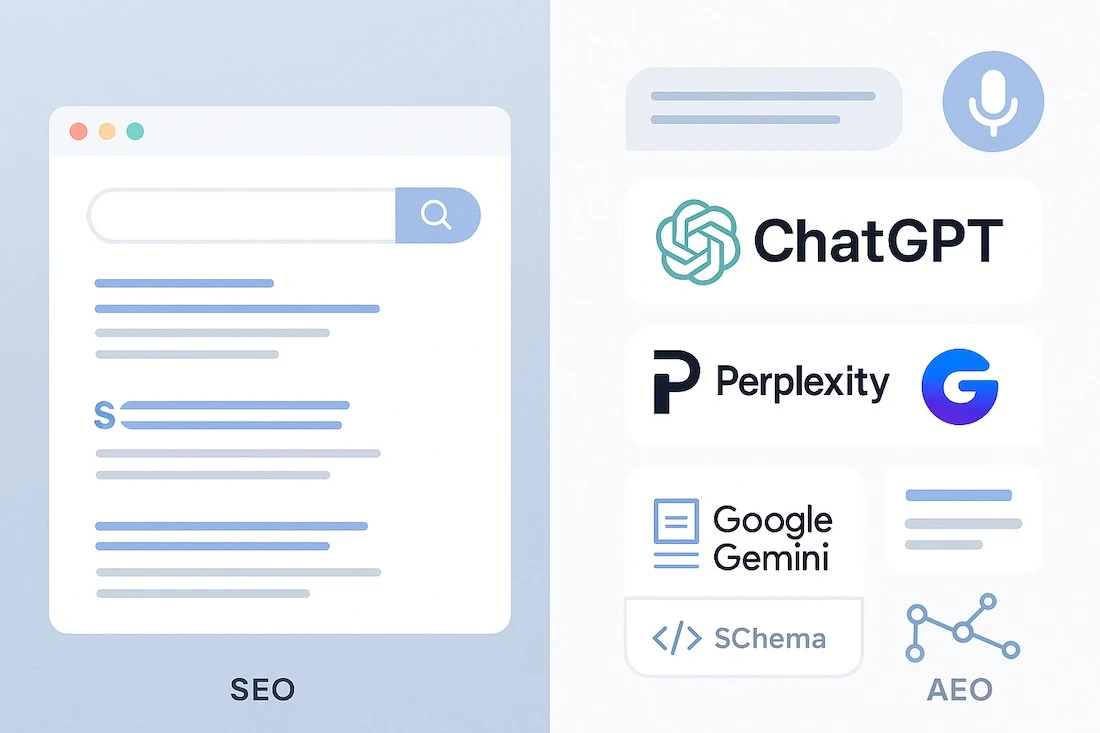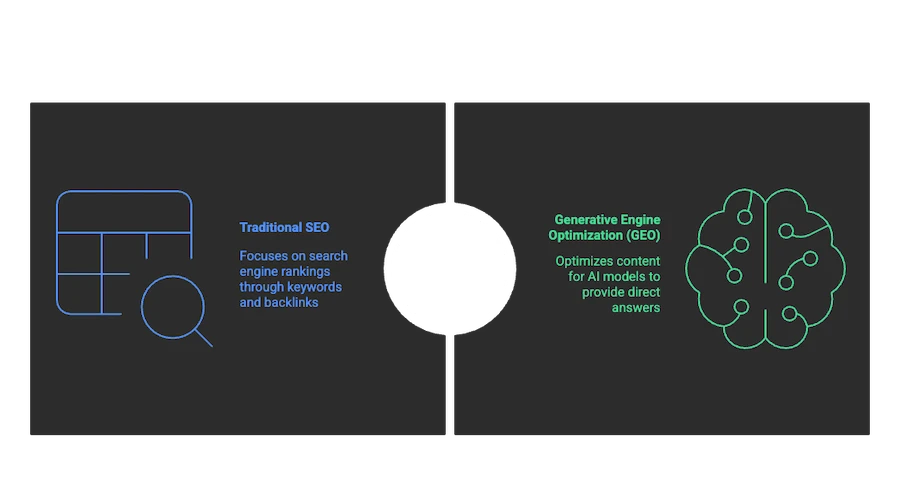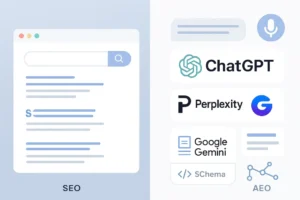The familiar blue links that once dominated Google search results are no longer the cornerstone of SEO. AI-powered tools like ChatGPT, Perplexity, and Google’s AI Overviews are transforming how people find information, providing direct answers instead of directing users to external websites. This shift demands a new approach: understanding and applying strategies like Generative Engine Optimization (GEO) and Answer Engine Optimization (AEO).
The future of SEO is being redefined by the need to cater to AI-first search engines, which prioritize instant, zero-click responses and visual search capabilities over the simple retrieval of a list of links. With AI-driven technologies driving these changes, businesses must shift focus from traffic-centric strategies to conversion-focused approaches that embrace new content creation and optimization tools. As voice and local searches gain traction, the traditional linear search journey transitions to a more dynamic interaction between users and search platforms.
The intricacies of these SEO trends, including the fall of the blue link and the strategies brands must adopt to remain relevant in this evolving space. We’ll explore the importance of GEO and AEO, the decline of traditional link paradigms, and the ways AI is reshaping the search frontier. Prepare to navigate the complexities of future SEO challenges and unlock the secrets to maintaining visibility in an AI-first world.
🔎 Key Takeaways
In 2025, traditional SEO is giving way to AI-first strategies that favor instant, direct answers over blue link rankings. Generative Engine Optimization (GEO) positions content to appear in conversational results from tools like ChatGPT and Gemini, while Answer Engine Optimization (AEO) focuses on structuring responses for zero-click environments and voice search. Success now depends on using structured data, topic clusters, and real-time insights to create content that is brief, reliable, and aligned with E-E-A-T standards. AI tools are reshaping how content is created and consumed, and brands must adapt to voice, visual, and local search trends. While GEO is becoming the dominant term, SEO continues to evolve, blending classic tactics with new AI-focused strategies to stay visible and competitive.
Generative Engine Optimization (GEO)
SEO trends are shifting towards Generative Engine Optimization (GEO) as search engines evolve. Traditional SEO methods, such as focusing on blue links, are becoming less effective. GEO is about making content discoverable and useful for AI-driven engines like ChatGPT and Google Gemini.
This approach marks a departure from old practices by prioritizing structured content for integration into generative AI models. GEO ensures content visibility through AI-generated responses rather than through traditional search listings. By adapting to GEO, brands can maintain online visibility and relevance in the AI-first search world.
Definition and Purpose of GEO
Generative Engine Optimization (GEO) is designed for an AI-driven search landscape. Unlike traditional SEO, which targets search engine rankings, GEO optimizes content for AI models. This involves creating structured content that AI can use for summaries and answers.
The goal is to make content a high-value and trustworthy source, preferred by AI engines. GEO’s purpose extends beyond keywords and backlinks. It focuses on direct answers facilitated by AI, rather than link lists. As AI transforms search habits, GEO is essential for integrating content into AI response mechanisms, ensuring online visibility.
Evolution of Keyword Strategies
SEO success hinges on understanding the intent behind keywords. Search engines and AI are getting better at predicting what users really want. This means SEO strategies must now address user problems directly. Rather than just targeting keywords like “fix leaky faucet,” businesses need to provide comprehensive solutions.
SEO tactics should identify new keyword opportunities and address competitors. Besides keywords, structured data and semantic optimization are crucial, helping content align with user intent and the digital landscape. This shift in strategy helps brands stay ahead in the evolving world of search.
Conversation-Driven Content Approaches
Modern SEO strategies must reflect how people naturally use search engines. Voice search optimization has become key, as it involves understanding longer, question-like queries. Businesses should now focus on long-tail keywords and natural language.
Creating content that answers common questions is a powerful way to capture voice search traffic. This requires moving from robotic phrasing to more natural, conversational formats. By doing so, businesses align with how users search, enhancing their SEO visibility. With a focus on conversations, brands can connect more effectively with their audience.
Entity-Based Optimization Techniques
Entity-based optimization is an advanced SEO strategy focusing on entities like people, places, and things. Unlike keyword targeting, this approach enhances contextual relevance in search results. Understanding the relationships between concepts helps build topical authority.
Resources like Wikipedia and Google’s Knowledge Graph are essential for this method.
Structured data, such as schema.org, aids machines in interpreting content contextually. Using semantically rich language helps AI engines understand and process the content better. This technique is vital for brands aiming to optimize SEO in an AI-powered world.
Integration of Real-Time Data
The integration of real-time data has transformed search engine results, offering quick, conversational answers. As AI leads these changes, SEO strategies must adapt. This includes using real-time data to enhance user engagement and visibility. The focus is shifting from just attracting traffic to improving conversion quality.
Hyper-personalized SEO needs real-time data analytics for tailoring content to users. Enhanced NLP capabilities enable complex searches, highlighting the need for real-time data. By using this approach, brands can align with voice search trends and meet evolving user expectations effectively.
Answer Engine Optimization (AEO)
The world of search engine optimization is shifting toward Answer Engine Optimization (AEO). The goal of AEO is to provide direct answers to user queries right within the search results.
This change is mainly driven by advancements in artificial intelligence (AI), where AI-generated answers dominate the top spots on search engine results pages (SERPs). AEO focuses on creating structured, entity-driven content that is easy for AI to understand. As a result, brands must rethink their SEO strategies to stay visible in this AI-first world.
Rise of Zero-Click Searches
In 2025, zero-click searches are more common than ever. These are results where users get what they need directly on the search engine results page, without clicking through to a site. AI-driven features like Google’s AI Overviews or ChatGPT answers are fueling this trend. To stay visible, brands must optimize content to be summarized clearly and cited by AI systems.
Impact of AI-Driven Search Technologies
AI technologies are reshaping SEO. AI enables rich query responses with advanced reasoning. Features like AI Overviews serve billions, changing how content gets ranked. It’s not just the quality of the content that matters now; user interaction plays a big role.
The rise of AI agents, which act autonomously in the search space, presents both a challenge and an opportunity for content creators. They must use data insights from AI tools while still applying human strategic expertise to excel.
Creating Direct Answers for Enhanced User Experience
To enhance user experience, direct answers are key. Knowledge panels and featured snippets quickly satisfy user queries by providing concise and accurate responses. Content needs to be expertly crafted and reliable to rank in these direct answer formats. It’s crucial for content to be structured with clear explanations that can easily fit into voice search and zero-click environments. This approach not only improves visibility but also user engagement and satisfaction.
Transition from Traditional Links to Instant Responses
The traditional use of blue links is giving way to instant search responses. AI-driven engines now offer personalized answers based on user habits, preferences, and location. SEO is increasingly coupled with digital marketing tools like social media and paid ads, creating a more connected response system.
The shift to zero-click optimization shows this trend of delivering immediate, direct answers. Visual SEO, featuring rich images, is also becoming popular to quickly answer user questions. Google’s AI mode is expanding, providing faster, more precise answers than the old search methods.
The Decline of the Blue Link Paradigm
In the evolving world of search engine optimization, the blue link paradigm is losing relevance. AI-powered tools like ChatGPT and Google’s AI Overviews are reshaping search dynamics. These tools tailor results to individual users, pushing the focus away from traditional blue link-centric SEO.

Now, SEO’s goal is more about discoverability across platforms instead of only optimizing blue links for Google. This broad approach includes integrating social media, paid ads, and other channels into SEO strategies. Brands must transition to a holistic approach to remain visible. As search engines evolve, businesses must adapt to stay ahead.
Analysis of Traffic-Centric vs. Conversion-Focused Strategies
A shift is occurring in how brands view digital traffic. The current SEO trends highlight the importance of both traffic-centric and conversion-focused strategies. Hybrid GEO-SEO strategies weave traditional keyword-focused methods with AI-friendly approaches. They optimize visibility and efficiency across multiple platforms. Structuring data, especially for FAQs and product pages, can improve clarity and boost visibility in rich results or snippets.
Brands should also diversify their traffic sources beyond SEO. Leveraging social media and email newsletters helps maintain brand visibility across platforms. As AI continues to improve searcher behavior understanding, creating adaptive SEO strategies aligned with user intent is crucial.
Emergence of Topic Clusters Over Keywords
Topic clusters are rising as a strategic approach over traditional keyword optimization. A topic cluster consists of a broad pillar page with multiple supporting pages that delve into related subtopics. By establishing a clear content hierarchy, search engines can better understand the relationships between content pieces, enhancing relevance. This approach often outperforms simple keyword reliance.
Topic clusters guide the user journey by offering comprehensive resources, addressing various decision-making processes. The strategy matches evolving content strategies that prioritize user intent and authority. Brands need to adopt this approach to stay relevant in the changing SEO landscape.
Role of AI in Content Creation and Optimization
AI tools are reshaping how content is created and optimized. These tools now integrate deeply into websites, highlighting the need to monitor AI-generated traffic using solutions like Google Analytics 4. SEO professionals recognize the value of AI tools in streamlining workflows, with a significant number already using them. AI-enhanced search results favor content that is brief and clear, offering curated summaries and conversational responses.
Structuring content using headings, bullet points, and lists helps AI systems parse information for search summaries. Businesses must adapt their SEO strategies to fit AI models by focusing on showcasing expertise, authority, and trustworthiness in their material. This ensures that their content remains part of the AI-generated responses, maintaining their online presence.
Expanding Search Frontiers
The world of search is expanding rapidly with the infusion of AI and evolving search algorithms. This change means that companies need to rethink their SEO strategies. It’s no longer about traditional ranking tactics. Instead, successful SEO now depends on both user experience and high-quality content. Generative Engine Optimization (GEO) is crucial as it shifts focus from traditional search engines to AI platforms.
As AI-driven answers become common, businesses must adapt. They need to ensure that their content is optimized to appear in these AI-generated responses. Moreover, companies should look beyond Google to capture new opportunities in the global market. By embracing these changes, businesses can stay ahead in the ever-evolving search landscape.
Growth of Visual Search
Visual search is becoming a powerful tool in shaping user decisions. As AI advancements enhance platforms like Google Lens and YouTube, optimizing for visual content is critical. Businesses that invest in visual SEO can see increased engagement and web traffic. Pictures and videos are not just eye-catching; they’re essential for digital marketing today. Visual content is prioritized in search engine results, so companies should focus on this area. By leveraging visual content, businesses can improve their digital presence and catch users’ attention more effectively.
Increasing Importance of Voice Search
Voice search continues to reshape the SEO landscape. Users often pose voice queries using conversational language, different from typed searches. This trend makes voice search optimization vital for businesses. Many voice searches are location-based, driving the need for strong local SEO strategies. Long-tail keywords and natural language help businesses appear in voice search results.
Properly optimizing a Google Business Profile ensures accurate business information is available to users. With voice search gaining popularity, optimizing for this feature offers businesses a chance to enhance visibility, particularly in focusing on local context.
Advancements in Local Search Techniques
Local SEO is becoming increasingly crucial as Google enhances algorithms to prioritize local content. This change connects users to nearby businesses more effectively. The Google Local Pack is an example of this focus on local relevancy. For businesses, having an optimized Google Business Profile is essential for effective local SEO. As more users make “near me” searches, strategies must focus on driving local traffic and leads. Local SEO remains vital for any business targeting geographic audiences and striving to keep a competitive edge in today’s digital space.
Navigating SEO Trends
As the digital landscape evolves, traditional SEO practices are being upended by AI-powered search engines. Two significant shifts are happening: Geographic Engine Optimization (GEO) and Answer Engine Optimization (AEO). These strategies align with AI-driven search behaviors, focusing on answering user queries and delivering relevant local results.
Businesses aiming to remain visible must adopt these new methodologies. GEO emphasizes dynamic content that responds to real-time data, ensuring local businesses harness local SEO opportunities. AEO focuses on making content easy for search engines to interpret, leading to greater visibility in AI-driven answer engines.
The overarching trend for SEO in 2025 is a shift from merely driving traffic to enhancing the quality of user interactions and conversions. AI platforms like ChatGPT and Gemini introduce new possibilities for content creation and strategic adaptations, setting the stage for an advanced approach to search engine optimization that is intelligence-first.
Schema Markup for Better Data Structuring
Schema markup is a critical tool for enhancing search visibility in an AI-dominated world. By using structured data like FAQs, products, and articles, businesses can ensure search engines and AI platforms understand their content. This understanding can lead to rich results, such as ratings and events, featured prominently in search results.
For example, a well-implemented schema markup can boost click-through rates by as much as 30% in large e-commerce sites. Structured data also helps define entity relationships and context, making your website more relevant to user search intent. To guarantee efficacy, employing tools like Google’s Rich Results Test can ensure proper implementation. By capitalizing on these tools, brands can improve their search appearance and enhance the user experience, fostering a more connected digital presence.
Implementation of Cross-Channel SEO Strategies
The SEO landscape of 2025 demands a comprehensive approach that transcends traditional silos. Successful cross-channel strategies integrate messaging across websites, social media, and video platforms like YouTube. This not only bolsters search engine placement but also enriches brand storytelling. In today’s digital ecosystem, leveraging signals from varied digital channels elevates content ranking.
Businesses, especially small ones, thrive by merging website content with social media efforts and engaging with audiences on external platforms. These cross-channel approaches blur traditional boundaries, creating a unified and coherent brand narrative. A strong digital presence ensures all content aligns with overall business goals, offering a seamless brand experience across the board.
Leveraging AI for Strategic SEO Adaptations
Incorporating AI into SEO strategies is now more important than ever. AI technologies offer predictive insights, determining trending keywords and high-potential content ideas through platforms like Surfer SEO. This blend of AI and human intelligence fortifies SEO efforts by crafting content that reflects user intent, a critical factor as AI’s understanding of search requirements continues to grow.
AI assists in generating draft content and enhancing data analysis, yet human creativity provides the strategic direction. For example, including structured FAQs and how-to guides increases the chances of content being featured in AI-generated search summaries, boosting visibility and engagement. The integration of AI in SEO promotes an agile adaptation to the evolving search landscape, ensuring continued success.
Transitioning to AI-First Search Ecosystems
The shift towards AI-first search ecosystems is reshaping how businesses approach digital marketing. AI tools like Perplexity and ChatGPT are creating competition for established players like Google, urging SEO practitioners to diversify their optimization efforts across different search engines. Personalized search powered by AI enhances user experience by delivering tailored results.
Therefore, businesses must focus on optimizing for E-E-A-T (Experience, Expertise, Authoritativeness, Trustworthiness) to stay relevant. The strategic use of generative AI and automation is essential in this transition, ensuring that content aligns with the AI-driven needs of today’s users. By adapting to these AI developments, brands can secure their place in this new era of search, maintaining their visibility and effectiveness in an ever-changing digital arena.
 Adapting to Future SEO Challenges
Adapting to Future SEO Challenges
Navigating the evolving world of SEO in 2025 requires understanding new trends and strategies. Search landscapes are shifting, with AI features like Google’s Search Generative Experience (SGE) reshaping how users get information. This change emphasizes the integration of conversational AI in search results.
Businesses must optimize content for AI-driven tools, a practice known as Generative Engine Optimization (GEO). As traditional search tactics decline, effective SEO involves blending new AI strategies with proven methods. Brands need to keep up with these changes to stay visible in the AI-first world. Utilizing AI tools and branching out content distribution are key strategies for maximizing SEO exposure across various search formats.
Skills Required for Future SEO Success
Future SEO success hinges on knowing how to merge traditional SEO with AI advancements. It’s about using AI to enhance, not replace, your efforts. SEO professionals must hone skills in optimizing for voice and visual searches, which are growing in use. Mastery of on-page elements like keyword targeting and metadata is vital.
Technical SEO skills, essential for search engine rankings, must be equally strong. Creating original content that offers unique perspectives and aligns with E-E-A-T signals is crucial. Adapting to semantic search is another skill; content should match user intent for sustained relevance in search technologies.
Continuous Learning and Adaptation Strategies
The world of SEO is in constant motion, with Google updates causing shifts in rankings. Staying pertinent requires a hybrid strategy that combines traditional methods with Generative Engine Optimization (GEO). This blend maximizes visibility while adapting to AI-driven trends. AI-assisted content creation is vital for aligning with user intent, enhancing the search experience.
Successful strategies cater to user needs at every stage, from research to purchase, boosting engagement and conversion rates. Moreover, aligning SEO strategies with values like eco-friendliness and social responsibility helps businesses stay competitive in the digital age. Continuous learning ensures SEO strategies remain effective in this dynamic landscape.
Other Acronyms Worth Mentioning
In the evolving world of SEO, understanding acronyms is key. Beyond the familiar terms like GEO and AEO, several others are gaining traction in 2025.
Acronym Overview:
- AIO (AI Optimization):
Optimize content for AI visibility and interaction. It’s essential for reaching AI-driven search tools. - LLMO (Large Language Model Optimization):
Focus on optimizing for LLMs. This can influence training set inclusion and citation likelihood. - ASO (AI Search Optimization):
Simplifies multiple terms under a single umbrella. It’s useful for AI-first search engines. - CAIO (Conversational AI Optimization):
Though less common, it’s important for voice assistants. - VEO (Voice Engine Optimization):
This is mostly historical. It has merged into AEO practices as voice search evolved.
Adapting to these trends will help brands stay visible. Implementing these strategies ensures alignment with modern search engine algorithms and user experiences. Adaptation remains crucial in our AI-driven world.
Will the Term “SEO” Disappear? Or Should It Evolve?
As generative AI transforms how users search and consume information, many marketers are wondering if “SEO” is still the right term. On one side, traditional SEO focused on ranking blue links in search engine results is clearly losing ground. AI tools like ChatGPT, Perplexity, and Google’s AI Overviews often skip links altogether and provide direct answers in real time.
At the same time, the core purpose of SEO remains valuable. Creating high-quality content, optimizing for discoverability, and building authority are still critical for online visibility.
These same principles now apply to newer strategies like GEO (Generative Engine Optimization) and AEO (Answer Engine Optimization). The difference is where and how that content appears—inside AI-generated answers, not just on a search results page. Rather than disappearing, SEO may be expanding. Some professionals argue it should evolve into a broader framework, sometimes called “AI Search Optimization,” that includes GEO, AEO, and classic SEO together. In the end, the name may change, but the goal is the same: helping content get seen by the right people in the right place.
Which Term Is the Industry Standard?
As of 2025, GEO is becoming the dominant term for AI and LLM-focused optimization. It is the most widely adopted label in forward-looking digital marketing conversations. GEO is featured regularly in expert analyses, webinars, and tools. Platforms like Relixir now refer to their approach as “AI GEO,” and influencers and venture capital firms such as a16z use the term to signal the shift away from traditional search.
Search trends and discussions show GEO leading conversations about visibility in AI-powered environments. Some analysts predict GEO will eventually replace SEO altogether. For example, Gartner forecasts a 25 percent drop in traditional search volume by 2026. AEO remains relevant, particularly for direct but non-generative answer formats, such as voice assistants or Google’s featured snippets. It is often seen as a transitional or umbrella term. While still valuable, AEO is less specific than GEO when it comes to optimizing for large language models and generative platforms.
Some industry voices believe that the growing number of acronyms, including SEO, AEO, GEO, LLMO, and AIO, is becoming excessive. They suggest simplifying everything under one concept, such as “AI Search Optimization,” to reduce confusion. Regardless of which term takes the lead, the goal remains the same: to build trust, deliver clear value, and make your content discoverable by both users and AI systems.
In practice, many experts recommend a combined approach. Blending classic SEO with AEO and GEO strategies provides the broadest possible visibility. These strategies share common tactics such as schema markup, E-E-A-T signals (Experience, Expertise, Authoritativeness, Trustworthiness), and question-based content.
About Adovex
Adovex is a digital marketing agency that specializes in AI-first strategies and online advertising, primarily serving law firms and healthcare providers. By focusing on Generative Engine Optimization (GEO), Answer Engine Optimization (AEO), and cross-channel campaigns, Adovex helps clients stay visible and attract quality leads across today’s evolving search platforms. From Google Ads and Meta campaigns to content marketing and AI-powered SEO, Adovex delivers results by combining innovative technology with practical business goals.













